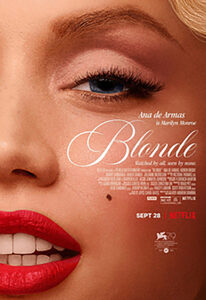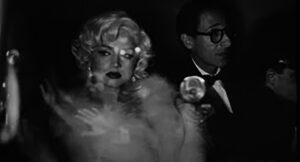By Scott Winfield Sublett
 The review in The New York Times of Blonde, the movie about Marilyn Monroe on Netflix, calls it ‘the latest necrophiliac entertainment to exploit her.’ The internet has piled on, too. My favorite: a young, female professor tweeting that Joyce Carol Oates, the author of the novel from which the movie was adapted, had no right to write about Marilyn because Marilyn was a hottie and Oates isn’t and non-hotties can’t know what it’s like. Twitter twaddle such as that is why the fiction writers I know are privately bemoaning that not long from now one won’t have the right to write about anybody but oneself.
The review in The New York Times of Blonde, the movie about Marilyn Monroe on Netflix, calls it ‘the latest necrophiliac entertainment to exploit her.’ The internet has piled on, too. My favorite: a young, female professor tweeting that Joyce Carol Oates, the author of the novel from which the movie was adapted, had no right to write about Marilyn because Marilyn was a hottie and Oates isn’t and non-hotties can’t know what it’s like. Twitter twaddle such as that is why the fiction writers I know are privately bemoaning that not long from now one won’t have the right to write about anybody but oneself.
A lot of critics are waxing dudgenly over Marilyn’s lack of agency in the film – her soft, apologetic victim-hood, and the way she acquiesces to abuse because she sometimes can’t tell the difference between it and love. I suspect that’s not far from the truth. Like so many victims of childhood molestation, her abusers convinced her that her sexiness was her only worth. The Marilyn in Blonde is soft, yielding, apologetic: a frightened doe. That seems to be the button that’s being pushed in the heads of the movie’s detractors. Blonde doesn’t follow the rule that depicting women as anything other than triumphant is a betrayal. Never mind that she’s only one character in one movie, not the cape-wearing avatar of her whole gender. The real Marilyn was indeed complicated – more assertive, harder, and shrewder than Blonde allows – but no movie, even one 166 minutes long, can include everything.
It’s worth noting that the over 700-page-long novel its based on, is explicitly fiction and, it should be noted, was a finalist for the Pulitzer Prize and National Book Award. The novelist, Oates, tweeted in defense of Blonde (faux-casually aping the Twitter style): ‘I think it was/is a brilliant work of cinematic art obviously not for everyone’. Surprising that in a post #MeToo era the stark exposure of sexual predation in Hollywood has been interpreted as ‘exploitation’. Surely Andrew Dominik [the director-screenwriter] meant to tell Norma Jeane’s story sincerely.”
Which is not to say that the predation dramatized in Blonde is easy to watch. The sustained scene where America’s most beloved martyred statesman orally assaults America’s most beloved martyred actress is shot from JFK’s point of view and narrated with Marilyn’s inner monologue as she gags, weeps, and persuades herself not to vomit. It’s meant to shock, and it does. Of course, Kennedy was a pig with women and ravenous. The roster of actresses he bonked includes Gene Tierney (devastated when he dumped her), Audrey Hepburn (looked so much like Jackie!), Angie Dickenson (sex with JFK was “the most exciting seven minutes of my life”), Marlene Dietrich, Lee Remick, and Jean Simmons (not the one from Kiss). And then there was Judith Campbell Exner, the mistress he shared with Mafia boss Sam Giancana. And by the way, who murdered Jack’s lover Mary Pinchot Meyer? And for that matter, who murdered Marilyn? Was it Bobby? These are not things we Democrats care to dwell upon.
Also difficult is the scene where Marilyn engages in an inner dialogue with a fetus who asks if she will terminate this one like the one she aborted. To dramatize a woman’s regrets about abortion (and by the way, I understand there’s no hard evidence Marilyn had one) provokes queasy questions around the role of art in a time of fascist encroachment on the rights of women. Furthermore, fetuses can’t talk. Writing them lines has political implications, intended or not.
Yet, I have to agree with Oates that this big, sumptuous adaptation of her novel is ‘a brilliant work of cinematic art,’ even if ‘obviously not for everyone.’ Since the Old Masters painted exquisite pictures of skulls and wounds, visual art has rendered hideous things in aesthetically pleasing ways, but Blonde brings something new to the party, at least insofar as the Hollywood movie is concerned. Much of it is daringly shot in black & white, making the stretches of color all the more ravishing: you can’t stop noticing the creamy, soft-focus sensuousness, the powdered and lacquered sheen, that aptly evokes the look of Playboy Magazine in the 1960s. Obviously, it’s a style originally designed to idealize the female form and therefore does the dramatically necessary job of capturing the compelling loveliness of Marilyn as embodied by the outstanding Cuban actress Ana de Armas. The Playboy aesthetic is, of course, kitsch, and the tension between that kitschiness and the film’s serious intentions somehow makes one think of Jeff Koons. So, too, does the fact that the director seizes every opportunity to display the actress’s breasts, but then, artists paint what they like to look at – hence all those penises on the ceiling of the Sistine Chapel and in the paintings of Alice Neel.

Netflix 2022
Interesting to a professor of film history is that Blonde belongs to a small, seductive subgenre of which it is the most artistically ambitious example: movies that address the tragic lives of Hollywood actresses whose destruction is somehow tangled up with their provocative sexuality. Let’s call it the Doomed Sex Symbol Genre, and it doesn’t matter if it’s a fictional character, or fiction inspired by a real actress, or a putative faithful biography, because they’re all so fictionalized that the boundary disappears. The genre customarily depicts the predations of Hollywood men, though never so explicitly as in Blonde. They’re movies about how fate elevates, then destroys, its darlings, and in that they’re a bit akin to Greek drama. The specimen with the best dialogue is Joseph Mankiewicz’s lush, glamorous The Barefoot Contessa, with Ava Gardner as a Spanish dancer who’s discovered by Humphrey Bogart. Another standout is 1965’s Harlow, with Carroll Baker, which I’ve watched on TV maybe 20 times and if it’s on TV this weekend I’ll consider catching it again. It’s trashy, brassy and brash, and its sheer, swaggering energy yanks you along, as does Neal Hefti’s haunting score.
The Doomed Sex Symbol Genre is tricky in that it’s often about someone falling apart, and people fall apart mostly for internal reasons – hard for a camera to see from the outside, but Blonde does a pretty good job of it. Maybe here’s the place to mention that Blonde takes us someplace I’ve never seen a camera go, a shot from an impossible point of view, that of a fetus inside Marilyn’s vagina. Can one go further than that? So, then, what’s the genre’s future? These days, the public, or at least the press and the young people most active on social media, want stories that demonstrate how every woman in history was a feminist centuries ahead of her time, completely oppressed but bravely fighting back, all the while smarter than every man in the room and winning in the end. Those things didn’t always happen in history, and they arguably cannot happen in the Doomed Sex Symbol Genre because, well, she’s doomed. And seeing beauties in their prime victimized and destroyed is a cringier proposition than it once was, especially if the doomed woman is participating in the process, which Marilyn did.
Netflix, the biggest streaming service on the planet (221.64 million paid subscribers) is famously cagey about box office numbers, but they claim Blonde is a hit. Maybe, but I predict that the Doomed Sex Symbol Genre won’t survive, and even if it does, one suspects that Blonde packs such a punch, and now occupies so much cultural space, that another Marilyn movie will be long in coming.
